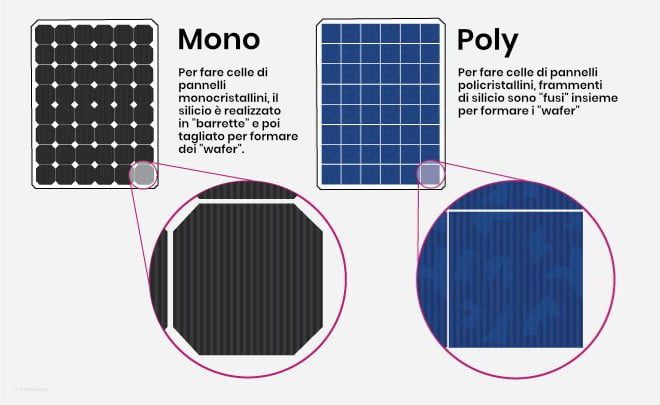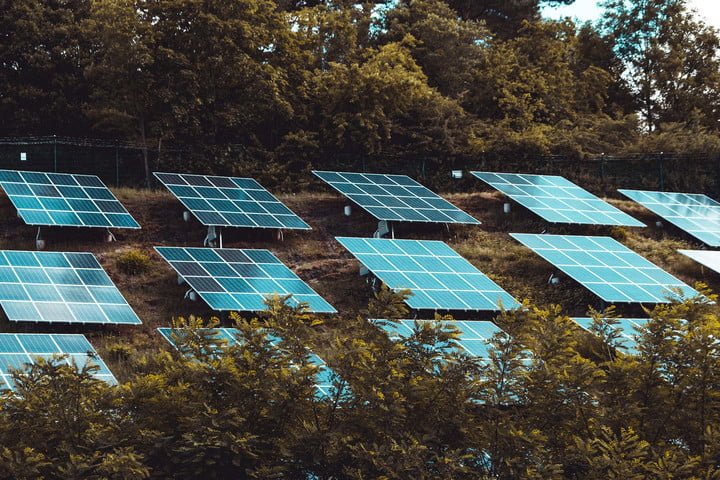What type of material forms solar panels? What is their average lifespan and what kind of impact do they have on the environment?
Each of these questions brings us back to a fundamental theme: are solar panels recyclable?
Considering the increase in production of new renewable energy systems, it is fair to ask how they interact with the environment. We know that the panels are designed to last up to twenty years, and that they allow us to fight climate change.
All we need to know is if solar panels can be considered as actually recyclable and, most importantly, how the disposal process works. Let's find out together, starting from the set of materials that allows them to be built.
What are solar panels made of?
To actually understand how much solar panels can be defined as recyclable, it is important to start from their basic constitution.
In general, each panel is produced using: glass, silicon cells and metal structures. In turn, the silicon cells can be monocrystalline or polycrystalline.
- Monocrystalline silicon is often considered to be more efficient, because it manages to create more resistant systems. The final color of the panel is quite dark. Their degree of efficiency ranges from 15% to 20%.
- Polycrystalline silicon is cheaper, and relies on different crystals. Typically, this type of solar panel has a blue tint. Their degree of efficiency ranges from 13% to 16%.
Speaking instead of the average lifespan of these materials, we can say that most solar panels last around twenty years. Several manufacturers guarantee buyers a resistance of 25 years, with a slight loss of efficiency in the last years of activity.
What are the damages to the environment?
One of the most dangerous elements regarding the environmental impact of solar panels is directly connected to their production.
The creation of solar panels begins with the extraction of silicon, which is derived from silica – which is in turn derived from quartz sand.
Almost all major mining takes place in China, and involves high production of carbon (Carbon isn't exactly good for the environment, but it's critical for mining. To release the silicon, we need to heat the carbon to a high temperature so we can combine the carbon with the silica.)
Thankfully, the latest silicon manufacturing methods have succeeded reduce by 12 times the carbon footprint. However, the amount of carbon produced is still too high to ignore.
At the end of its life, a solar panel releases cadmium, lead, indium, molybdenum and tellurium into the ground. However, the quantities are too low to constitute a concrete environmental risk. (an interesting one was conducted in this regard Research)
If manufacturers can lower their carbon footprint even further, solar panels could become an even more beneficial element for environmental health.
Can solar panels be recycled?

Thanks to the work of the designers, we know that solar panels can be recycled, and that they can be transformed into new polycrystalline panels.
It is necessary to reconstruct the metals, but the process is not very aggressive and manages to make them maintain their degree of purity. The same also applies to silicon, which is basically a metalloid (a material that has some aspects of metals).
Lately, Europe has forced manufacturers to supply recycling options for their solar panels. The objective is to reduce the environmental impact and encourage a more "green" production style.
Unfortunately, the United States has not made the same step. This means, that still 76% of producers does not recycle or reuse its panels.
The recycling process
There is not yet an "official" method for recycling solar panels.
A project carried out in collaboration with the Fraunhofer Institute for Solar Energy Systems was able to increase the efficiency of a solar panel after going through the recycling process. However, it did not provide unique answers for all panels.
To tackle the recycling process, it is necessary to identify the individual modules that are still usable, deal with the extraction of individual components, the extraction of certain raw materials, taking care not to ruin anything.
Each process brings with it additional costs, which must then be taken into consideration. Basically, recycling solar panels is quite difficult. Incentives and research into the best recycling methods need to increase, especially considering how many solar panels there are still to be built.


